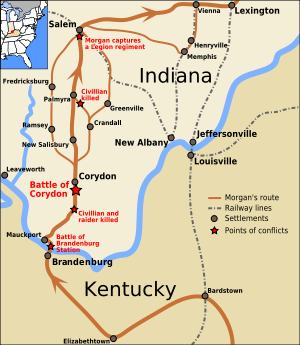ARNOLD ELDER was born January 30, 1810 in Washington Co., KY, and died September 22, 1854 in Perry Co., IN. He married MARY REBECCA HARGIS June 10, 1837 in Perry Co., IN, daughter of JOHN HARGIS and NANCY ALLEN. She was born July 24, 1821 in Derby, Perry Co., Indiana, and died December 16, 1901 in Rooks Co., KS.
In 1860 Mary (Marey/Masey), age 38 from IN, was a merchant in Perry Co., IN (page 842) with p roperty valued at $1,600 and personal assets of $1,000; at home were George F, from IN; Na ncy C., from IN; Thomas G., from IN; Arnold A., from IN.
The family owned a store a half mile east of Derby on the Ohio River. During the Civil War, M ary became nervous about Morgan’s Raiders, so she sold out and moved to Oil Creek in Perry Co . to be away from the river.
Indiana

Historical marker noting Morgan’s activities at Brandenburg, Kentucky, where his forces captured two steamboats, the John B. McCombs and the Alice Dean, before crossing the Ohio River into Indiana
Morgan had sent spy Thomas Hines and a party of 25 Confederates, posing as a Union patrol, on a secret mission into Indiana in June to determine if the local Copperheads would support or join Morgan’s impending raid. After visiting the local Copperhead leader, Dr. William A. Bowles, Hines learned that no desired support would be forthcoming. He and his scouts were soon identified as actually being Confederates, and, in a small skirmish near Leavenworth, Indiana, Hines had to abandon his men as he swam across the Ohio River under gunfire. He wandered around Kentucky for a week seeking information on Morgan’s whereabouts.
By now reduced to 1,800 men, Morgan’s main column had arrived on the morning of July 8 at Brandenburg, Kentucky, a small town along the Ohio River, where Hines rejoined them. Here, the raiders seized two steamboats, the John B. McCombs and the Alice Dean. Morgan, against Bragg’s strict orders,[5] transported his command across the river to Indiana, landing just east of Mauckport. A small company of Indiana home guards contested the crossing with an artillery piece, as did a riverboat carrying a six-pounder. Morgan chased off the local defenders, capturing a sizeable portion as well as their guns. After burning the Alice Dean and sending the John B. McCombs downriver with instructions not to pursue him, Morgan headed away from the river.
Governor Oliver P. Morton worked feverishly to organize Indiana’s defense, calling for able-bodied men to take up arms and form militia companies. Thousands responded and organized themselves into companies and regiments. Col. Lewis Jordan took command of the 450 members of the Harrison County Home Guard (Sixth Regiment, Indiana Legion), consisting of poorly trained civilians with a motley collection of arms. His goal was to delay Morgan long enough for Union reinforcements to arrive.
Maj. Gen. Ambrose Burnside, commander of the Department of the Ohio with headquarters in Cincinnati, quickly organized local Federal troops and home militia to cut off Morgan’s routes back to the South. Morgan headed northward on Mauckport Road, with another brother, Colonel Richard Morgan, leading the forward elements. On July 9, one mile south of Corydon, Indiana, the county seat of Harrison County, his advance guard encountered Jordan’s small force, drawn in a battle line behind a hastily thrown up barricade of logs. The colonel attacked, and in a short but spirited battle of less than an hour, he simultaneously outflanked both Union wings, completely routing the hapless militia. Accounts vary as to the number of casualties of the Battle of Corydon, but the most reliable evidence suggests that 4 of Jordan’s men were killed, 10-12 were wounded, and 355 were captured. Morgan counted 11 dead and 40 wounded raiders. Among the dead Federals was the civilian toll keeper who perished near his tollgate. Raiders killed a Lutheran minister, Reverend Peter Glenn, on his farm, 4 miles (6 km) from the battlefield, and stole horses from several other farmers.
General Morgan led his division into Corydon, where he paroled his demoralized prisoners and ransomed the town for cash and supplies. Morgan’s soldiers then traveled east and reached Vienna on July 10, where they burned a railroad bridge and depot, and tapped a telegraph line. After spending the night in Lexington, they headed to the northeast, terrorizing the small towns along the way, including Vernon, Dupont, New Pekin, Salem, and Versailles.
On July 11, while crossing Blue River near New Pekin, Confederate Capt. William J. Davis and some of his men were captured by 73rd Indiana Infantry and a detachment of the 5th U.S. Regulars. Davis and several other soldiers were taken to New Albany and secured in the county jail.
On July 12, Morgan arrived in the town of Dupont, Indiana, where his men burned the town’s storehouse and stole 2,000 smoked hams before riding out of town the next day. The hams were eventually discarded as they began to attract flies, leaving a trail of hams along the side of the road for the pursuing Union Army to follow.
Morgan then headed for Salem where he immediately took possession of the town and placed guards over the stores and streets. His cavalrymen burned the large brick depot, along with all the railcars on the track and the railroad bridges on each side of town. They demanded taxes from area flour and grist mills. After looting stores and taking about $500, they departed in the afternoon.
In Versailles a group of freebooters invaded the local Masonic Lodge, Versailles No. 7, and lifted the Lodge’s badges of office which had originally been made from French silver coins. Morgan, himself a Freemason, ordered the officers’ jewels returned, punishing the thievery of his own men.[6]
Morgan finally left Indiana at Harrison, closely pursued by Federal cavalry.